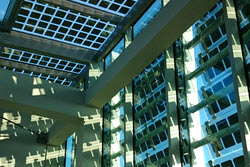Integrated window system aims to cut heat loss – and provide warmth
The MLSYSTEM project aims to deliver a multifunctional window to the European marketplace by combining a glazed insulating glass unit with the latest semi-transparent photovoltaic (PV) technologies. This innovative solution will allow for the environmentally friendly production of electricity through a PV panel, which is integrated into the glass unit. At the same time, the window unit transfers solar thermal energy into a room to provide a low-cost heating option. In addition, the MLSYSTEM design promises to deliver superior thermal insulation compared to standard windows. Thanks to these features, the owners and administrators of buildings will have the opportunity to significantly increase the efficiency of their energy consumption. This will be achieved by decreasing energy costs and reducing demand for fossil fuel energy sources. Furthermore, the solution will deliver high levels of optical transparency when dye-sensitised solar cells (DSSC) are used as a photovoltaic. The MLSYSTEM can be used not only as windows and in rooftops, but also as a variety of facades such as curtain walls in buildings, glass surfaces, vestibules, entrance enclosures, skylights, internal walls, partitions and garden structures. These places were previously unsuitable for PV installations. The window is expected to be an especially attractive option for Europe’s new, ultra-low energy buildings. The project team expect commercialisation of the final product to target real estate developers as a first step. There is also potential to deliver a product for sale to individual households in the future. The project is currently finalising a study to verify the technological feasibility and economic viability of commercialising its window. This assessment is phase one of the project development. The next step will be to apply for phase two funding through Horizon 2020 (SME Instrument) so that the complex research and development can be carried out to assess further the product’s manufacturing and market potential. So far, a prototype window has been built and tested in a laboratory, with promising results. ‘The outcomes of the tests have given us the confidence that we can go on to achieve the project’s overall goals,’ explained project coordinator, Anna Warzybok. ‘Implementation of the MLSYSTEM will contribute to reducing problems associated with CO2 emissions from buildings – this is important when considering that about 30 % of energy consumed by buildings is used unnecessarily or inefficiently.’
Countries
Poland



